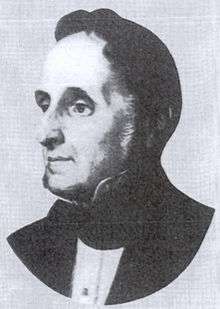Emanuele Fenzi
Emanuele Fenzi (1784–1875) was a leading Italian banker, iron producer, concessionaire of the Livorno–Florence railway and other railway enterprises, merchant for exportation of Tuscan products, and landowner. Made Senator of the Grand Duchy of Tuscany and later of the Kingdom of Italy, Knight of the Sacred Military Order of Saint Stephen, Pope and Martyr, and Knight of the Order of Saint Joseph. He lived in these places: Palazzo di Via San Gallo, Villa Rusciano Villa Fenzi at Sant’Andrea in Percussina, and at a house in the city of Livorno. He was the grandfather of horticulturist Emanuele Orazio Fenzi and the great-grandfather of Ida Fenzi.

He was the son of judge and jurist Cav. Jacopo Orazio Fenzi, after the death of his father (1803) was only nineteen and having already to provide for the family. Having already proved himself a worthy entrepreneur under his fathers guidance, Count Fenzi acquired in 1805 the management of Bosi, Mazzarelli & Co., his entrepreneurial sense was rewarded by the economic success of the company.
In 1810 he bought a building on Corso dei Tintori and married the daughter of a Milanese aristocrat and merchant Countess Ernesta Paffetta dei Lamberti; they had four children. The same year with some fellow members of Bosi, Mazzarelli & Co he founded Bosi, Mazzarelli & Co., specializing in the manufacture and sale of tobacco and gained the monopole of the tobacco industry within the Grand Duchy of Tuscany between 1814 and 1820.
By 1821, Fenzi established the Banca Fenzi, which was soon to branch out all over Italy and Europe. He opened a branch in Piazza della Signoria and from 1829 it acquired a Palazzo on Via San Gallo that was to become the Palazzo Fenzi, that had been put up for sale after the extinction of the Marucelli family.
The Livorno banking house of Senn joined with the Florentine firm of Fenzi to secure the concession for the Strada Ferrata Leopolda, designed to link Leghorn with Florence by way of Empoli, and the line was begun in 1841, to be finished ultimately in June 1848. By 1845 the desire for a network of railways had led, according to one estimate, to sixteen projects which lay on the grand duke's desk for consideration.
In 1835 Fenzi seized the opportunity to finance the planned construction of the railway line between Florence and the port of Livorno, the Leopold railway, with the contractor Swiss French Pierre Senn of Livorno, hence entering into a contract with the Grand Ducal government in 1838. The railway was one of the first in Italy and was named Leopolda in honour of the Grand Duke Leopold II of Lorraine.
He had a career as a politician as member of the Tuscan Senate between 1848 and 1849 and was amongst the biggest supporters of the return of the Grand Duke in Tuscany. After the fall of the Grand Duke he became senator of the new Kingdom of Italy in 1860, having sworn loyalty to the new government.
Sources
- Cambridge Journals, Isabella Bigazzi / Zeffiro Ciuffoletti
- "Palazzo Marucelli Fenzi Guida storico-artistica" Fenzi Family Archive Trust. Archivo Fenzi, Biblioteca de Risorgimento.
- "Il Possesso di Rusciano" EDIZIONI A.G.M. FIRENZE 1990.
- The Life of Emanuel Fenzi, Andrea Giutini, Postampa 2002.
- Verity Family Records; Glamorgan Archives D/DXcb and DXBT, including the letters of Sebastiano Fenzi and Florence Cox from Sant' Andrea.
See also
External links
| Wikimedia Commons has media related to Emanuele Fenzi. |